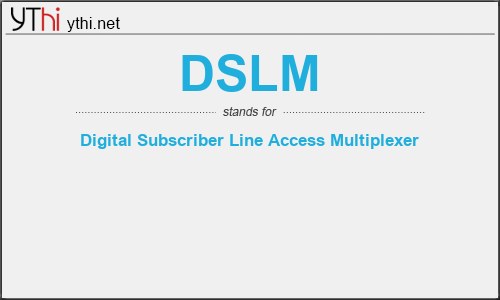What does DSLM mean? What is the full form of DSLM?
The Full Form of DSLM is Digital Subscriber Line Access Multiplexer.
A DSLAM, standing for Digital Subscriber Line Access Multiplexer, is a piece of hardware that splits the voice from the data traffic. This device is located within the POP (Point of Presence) of a local operator, also called the Exchange, property of the ISP or Internet Service Provider.
Thanks to a DSLAM, which is designed to handle incoming ADSL signals, we can have several customers connecting to different ports on the same device while sharing a single internet backbone, usually over ATM (Asynchronous Transfer Mode), standing behind, by multiplexing techniques.
Each single physical line is connected to a single port on a DSLAM device so there is no line sharing or contention ratio at this point, it is then said that the contention is 1:1 as one customer’s line goes to its very own port on the DSLAM. It really depends on how many ports are in use in a precise DSLAM to know how bad your connection can be in a worst case scenario.
We could have an ADSL internet access connecting to a DSLAM with a total of 20 ports in use. In that case we would have an ADSL with a pretty good 1:20 ratio. This would be a business type of ADSL which normally go from 1:5 to 1:20. Residential lines would usually be around 1:50. Well, in our example the internet backbone would be shared by up to 20 different customers. So if you connect at a rare time the backbone bandwidth would be just for you then experiencing a good relative speed performance. On the other hand if you connect to the internet during the day time your connection bandwidth will have to be split in equal parts among all online customers while slowing down your speed. At least we can know our CIR (Committed Information Rate) prior to order our access, which will reflect a worst case scenario, so our guaranteed bandwidth once all DSLAM customer ports are in use. It is not very common to see ISPs detailing this information for residential solutions but it is usually key for businesses due to their application requirements.
In terms of availability you would need to have a DSLAM close to your location. If you are located more than approximately 5Km away from a DSLAM you should start looking for a different technology, either fully dedicated over copper or a radio link for example. The provider, by receiving a valid analogical telephone number, will immediately see what options are available by just introducing it into their system. The maximum bandwidth reachable will always depend on the distance (due to signal attenuation) and the quality of the copper pair.
DSLM
means
Digital Subscriber Line Access Multiplexer![]()
Translate Digital Subscriber Line Access Multiplexer to other language.


Leave a Reply
You must be logged in to post a comment.